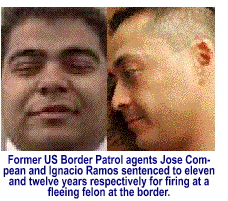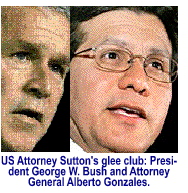
News
Behind the Headlines
Two-Cents Worth
Video of the Week
News Blurbs
Articles
Testimony
Bible Questions
Internet Articles (2015)
Internet Articles (2014)
Internet
Articles (2013)
Internet Articles (2012)
Internet Articles (2011)
Internet Articles (2010)
Internet Articles
(2009)
Internet Articles (2008)
Internet Articles (2007)
Internet Articles (2006)
Internet Articles (2005)
Internet Articles (2004)
Internet Articles (2003)
Internet Articles (2002)
Internet Articles (2001)


 n
Feb. 17, 2005 drug smuggler Osvaldo Aldrete-Davila loaded
up his van with 743 lbs of marijuana and headed for the US border
where he expected to deliver his illegal cargo to waiting drug dealers
in the United States. Within 48 hours, Aldrete-Davila believed
his marijuana would be in the distribution pipeline and he would
be back in Mexico awaiting his next drug deal. Only, that night
would not be a typical run for the drug smuggler. That night, he
would cross paths with a couple of US Border Patrol agent—and
the encounter would change their lives forever. It would also have
cause to make the American people wonder on which side of the illegal
invasion of America their government stood because what happened
should not transpire between a criminal who avoided arrest while
smuggling a million dollar's worth of marijuana into the country
and the US Department of Justice. It smells like rotten mackerel.
n
Feb. 17, 2005 drug smuggler Osvaldo Aldrete-Davila loaded
up his van with 743 lbs of marijuana and headed for the US border
where he expected to deliver his illegal cargo to waiting drug dealers
in the United States. Within 48 hours, Aldrete-Davila believed
his marijuana would be in the distribution pipeline and he would
be back in Mexico awaiting his next drug deal. Only, that night
would not be a typical run for the drug smuggler. That night, he
would cross paths with a couple of US Border Patrol agent—and
the encounter would change their lives forever. It would also have
cause to make the American people wonder on which side of the illegal
invasion of America their government stood because what happened
should not transpire between a criminal who avoided arrest while
smuggling a million dollar's worth of marijuana into the country
and the US Department of Justice. It smells like rotten mackerel.
 Border
Patrol agent Jose Alonso Compean, age 28, was driving on
the levee road near the Rio Grande in Fabens, Texas, some 40 miles
southeast of El Paso when he spotted a suspicious van moving at
high speed ahead of him, heading north. Compean called for
backup. Responding to his call for help was 37-year old Border Patrol
agent Ignacio Ramos who had arrested over 100 drug smugglers
during his career with the Border Patrol. Ramos is an 8-year
veteran of the US Navy, and was a former "Border Patrol
Agent-of-the-year" nominee. A third, unidentified, Border
Patrol agent was already chasing the van. He would avoid prosecution
by agreeing to testify against Ramos and Compean.
Driving the van was Aldrete-Davila.
Border
Patrol agent Jose Alonso Compean, age 28, was driving on
the levee road near the Rio Grande in Fabens, Texas, some 40 miles
southeast of El Paso when he spotted a suspicious van moving at
high speed ahead of him, heading north. Compean called for
backup. Responding to his call for help was 37-year old Border Patrol
agent Ignacio Ramos who had arrested over 100 drug smugglers
during his career with the Border Patrol. Ramos is an 8-year
veteran of the US Navy, and was a former "Border Patrol
Agent-of-the-year" nominee. A third, unidentified, Border
Patrol agent was already chasing the van. He would avoid prosecution
by agreeing to testify against Ramos and Compean.
Driving the van was Aldrete-Davila.
When Aldrete-Davila reached the outskirts of Fabens, he realized he would not be able to outrun the law enforcement officers and decided to try to get his contraband back across the Mexican border in order to avoid arrest and the seizure of his million dollar cargo. Compean, who was coming upon the chase from a different direction, realized Aldrete-Davila was going to try to get back across the border. He positioned himself between the fleeing drug runner and the two agents who were in hot pursuit. Had Compean been a little bit bigger man, or had the Mexican smuggler been less powerful physically, the chase would have ended different. It would have been just another night on the border and the three Border Patrol agents would have been heralded as heroes who kept a million dollars of marijuana off of America's streets—and out of our schools.
Realizing he could not save both the contraband and himself, Aldrete-Davila abandoned his van on the levee and began running to the river—into the waiting Compean. As he neared the levee, Ramos could hear Compean shouting at the fleeing illegal to stop as he crossed one of the canals. Shots rang out changing, in the mind of Ramos, the danger level of the chase. Ramos would later testify that "...[a]t some point during the time where I'm crossing the canal, I hear shots being fired. Later, I see Compean on the ground, but I keep running after the smuggler." Through the thick dust Ramos saw Aldrete-Davila, who was turning to face him. Ramos testified that he saw what appeared to be a nickle-plated gun in his hand. Believing his life was in danger, he fired. "I shot," Ramos continued. "But I didn't think he was hit because he kept running into the brush and disappeared. Later we all watched as he jumped into a van [on the other side of the border] waiting for him. He seemed fine. It didn't look like he had been hit at all." By that time seven other Border Patrol agents—including two supervisors—were on the scene. Compean, who fired at the fleeing illegal after he was physically attacked by the man, picked up his shell casing. Ramos did not.
Among
the charges leveled on the two agents was that they concealed the
fact that they had discharged their weapons at a fleeing suspect
and that they contaminated the "crime scene" when Compean
picked up his shell casings. According to the ICE Border Protection
Table of Offenses and Penalties, failure to report that a weapon
was discharged in the line of duty is punishable by suspension for
5 days.  Assistant
US Attorney Debra Kanof, who would prosecute Ramos
and Compean, argued that the agents attempted to conceal
the fact that they had discharged their weapons—even though
the two supervisors who arrived at the scene knew that shots had
been fired. But, because neither agent could remember specifically
telling the supervisors something they knew, nor filed the paperwork
confirming supervisors had been notified that they had fired shots,
the government charged them with conspiracy to conceal evidence.
Assistant
US Attorney Debra Kanof, who would prosecute Ramos
and Compean, argued that the agents attempted to conceal
the fact that they had discharged their weapons—even though
the two supervisors who arrived at the scene knew that shots had
been fired. But, because neither agent could remember specifically
telling the supervisors something they knew, nor filed the paperwork
confirming supervisors had been notified that they had fired shots,
the government charged them with conspiracy to conceal evidence.
Even with
that, the case didn't start to get weird for two weeks. The government's
version of what happened is, bluntly speaking, a fabrication. It's
a lie because the chain of events we are being asked by the US Attorney
to believe are not logical. If they aren't logical, they aren't
true. Pre-Law 101. What the government suggests happened next simply
doesn't pass the smell test.  And,
because it doesn't pass the smell test, its probably not true—particularly
when you examine the cast of characters—and their closeness
to US Attorney General Alberto Gonzales, President George
W. Bush—who played a role in the politicized railroading
of two Border Patrol agents—and the open border agenda of the
President. The question is—why?
And,
because it doesn't pass the smell test, its probably not true—particularly
when you examine the cast of characters—and their closeness
to US Attorney General Alberto Gonzales, President George
W. Bush—who played a role in the politicized railroading
of two Border Patrol agents—and the open border agenda of the
President. The question is—why?
How, and why, did the Bush Administration—at the highest levels—get involved in a what appears to be a bloodless, five minute fray between the Border Patrol in Fabens, Texas, and a narco-trafficker who left a million dollars worth of marijuana on the levee in Fabens as he scrambled back to Mexico? What does a cartel druglord do to a runner who loses his merchandise? Particularly a druglord with the power to put a bounty on the heads of the law enforcement officers who seized his drugs? Or a drug lord with friends high enough in the Vicente Fox government to apply pressure on the Bush Administration? I don't think either Compean or Ramos hit Aldrete-Davila when they fired at him. Nor should the testimony from the eye witnesses who saw the smuggler jump into a van on the other side of the border although they were all given immunity and compelled to testify against Compean and Ramos unless they were expertly coached on how to make "facts" out of vague suspicions. It is far more likely that the drug lord who employed Aldrete-Davila to deliver the cargo of marijuana to buyers on the US side of the border, deliberately shot Aldrete-Davila in the buttock as a warning to other drug runners to protect their contraband with their lives.
 Instead,
what happened two weeks after the incident was the unexpected involvement
of Bush-loyalist US Attorney Johnny Sutton who is
headquartered in San Antonio. Sutton is the US Attorney for
the Western District of Texas which includes El Paso. Generally,
the mundane cases that arise in El Paso are handled by Chief Assistant
US Attorney Margaret Leachman. (The shooting at/of an illegal
alien smuggling marijuana into the United States would be one of
those mundane cases that should have fallen under the purview of
Leachman. and not Sutton-loyalist Assistant US Attorney
Juanita Fielden). Sutton is plugged into the power
structure of the Bush Administration, and has very close
ties to both Bush-43 and US Attorney General Alberto Gonzales.
He is one of Bush-43's "can-do" guys. Sutton,
a former assistant District Attorney in Harris County, Texas, hitched
his wagon to Gov. George W. Bush's star in 1995. When Bush
won the presidency, Sutton served as policy coordinator for
the Bush-Cheney transition team. He went to Washington, DC
as an Associate Deputy US Attorney General and, in Nov., 2001, Bush
appointed him US Attorney for the Western District of Texas with
118 lawyers under him. It's rumored inside the beltway that Bush
is will appoint Sutton to the federal bench before he leaves
office on Jan. 20, 2009.
Instead,
what happened two weeks after the incident was the unexpected involvement
of Bush-loyalist US Attorney Johnny Sutton who is
headquartered in San Antonio. Sutton is the US Attorney for
the Western District of Texas which includes El Paso. Generally,
the mundane cases that arise in El Paso are handled by Chief Assistant
US Attorney Margaret Leachman. (The shooting at/of an illegal
alien smuggling marijuana into the United States would be one of
those mundane cases that should have fallen under the purview of
Leachman. and not Sutton-loyalist Assistant US Attorney
Juanita Fielden). Sutton is plugged into the power
structure of the Bush Administration, and has very close
ties to both Bush-43 and US Attorney General Alberto Gonzales.
He is one of Bush-43's "can-do" guys. Sutton,
a former assistant District Attorney in Harris County, Texas, hitched
his wagon to Gov. George W. Bush's star in 1995. When Bush
won the presidency, Sutton served as policy coordinator for
the Bush-Cheney transition team. He went to Washington, DC
as an Associate Deputy US Attorney General and, in Nov., 2001, Bush
appointed him US Attorney for the Western District of Texas with
118 lawyers under him. It's rumored inside the beltway that Bush
is will appoint Sutton to the federal bench before he leaves
office on Jan. 20, 2009.
The official version of the story from the government that led to the arrest and prosecution of Compean and Ramos is that the mother-in-law of US Border Patrol agent Rene Sanchez, Gregoria Toquinto (in Wilcox, Arizona), received a telephone call from Aldrete-Davila's mother, Marcadia Aldrete-Davila (in Mexico), to complain to Toquinto that Border Patrol agents shot her son in the urethra. The story smells like month-old mackerel.
Why would a Mexican drug runner's mother call the mother-in-law of a US Border Patrol agent and tell her that her son was shot by the Border Patrol after dumping a million dollars worth of marijuana? And, how would she know her? And, finally, why would she finger her own son? Logic suggests if such a conversation actually occurred, the US attorney should have been more curious how the drug runner's mother knew the mother-in-law of a Border Patrol agent, and whether or not she or her son-in-law had any personal "ties" to the drug runner. Clearly, if Aldrete's mother in Mexico has ties with Sanchez's mother-in-law in the United States, you would think both the Border Patrol and the DEA would have wanted to tap both phones to see who Aldrete-Davila and Sanchez were talking to—both in the United States and Mexico.
Without answers to any of those questions, its unreasonable to assume that a competent US Attorney would proceed—or that the US Attorney General or the head of the Department of Homeland Security would send an investigator from the Inspector General's office, Christopher Sanchez (no relation to the Border Patrol agent), to Mexico to interview Aldrete-Davila—and offer him immunity to testify against the two agents who theoretically shot him. In addition, based on the "evidence" that two dedicated Border Patrol agents were somehow more of a threat to the security of the United States than a drug runner who was almost caught with a million dollars worth of marijuana, the US government agreed to repair the smuggler's urethra. which was damaged when he was shot—by whomever shot him. When this one becomes a movie, everyone will recognize it as pure fiction.
When Compean and Ramos were arrested, logic suggests their supervisors would have called them in to the office where they would have peacefully surrendered to the FBI or US Marshals. Instead, the Department of Homeland Security staged a simultaneous SWAT assault on their respective homes, deliberately traumatizing their families. The SWAT teams from Homeland Security were belligerent and hostile—the type of arrest you might see when the criminal was an illegal alien from Mexico with a million dollars worth of marijuana hidden in his house. There is no doubt that the use of a SWAT team to arrest the two former officers was not out of fear for the safety of the arresting officers, but to instill fear—not only in the families of those who were being arrested, but other Border Patrol agents who will now think twice before doing their jobs on the border.
Assistant US Attorney Debra Kanof pointed out at the trial of Ramos and Compean that the Border Patrol agents violated Aldrete-Davila's civil rights by shooting him as he fled from the scene of his crime. What civil rights should an illegal alien—stealing into the country with 743 pounds of illegal marijuana expect? None. Or, at least, no more than any other felon who has no legal right to be in this country. The Bill of Rights should be narrowly construed by US Courts to protect [a] natural or naturalized citizens of the United States and/or [b] legal residents living lawfully within this nation. Illegal aliens, just like the citizens of any other nation within the UN are, and legally should be, protected only by the tenets of the UN Universal Declaration on Human Rights since it binds the governments and peoples of all other nations on Earth. The Constitution of the United States should not provide blanket amnesty for all peoples of all nations since it is a national document, not an international one. The preamble of the Constitution begin: "We the people of the United States..." not "We the people of the world..." The "people" of the United States are citizens—natural or naturalized—not illegal aliens who sneak into the country to conduct their criminal activities and do harm to the American people.
Further, as Kanof spoke to the jury, she pointed out that US Border Patrol regulations forbids agents from shooting unarmed felons, telling them it was a violation of the 4th Amendment—which, of course, it's not. The 4th Amendment guarantees "...[t]he right of the [citizen] to be secure in their person, houses, papers, and effects, against unreasonable searches and seizures, shall not be violated, and no warrants shall issue but upon probable cause, supported by oath or affirmation, and particularly describing the place to be searched, and the persons or things to be seized." Absolutely nothing there prevents Border Patrol agents from shooting at a fleeing felon who is evading arrest for drug smuggling—and who has assaulted a federal agent in the commission of a felony.
Other than Aldrete-Davila's word that he was shot by the Border Patrol while trying to evade capture, there was no mention of a blood trail to suggest he had been hit by the shots fired by either Ramos or Compean—information the government would have released in order to poison the jury pool if evidence existed that Aldrete-Davila had been hit by shots fired by either agent. Had Compean hit him, the blood trail would have started at the levee. Had Ramos hit him, the blood trail would have started closer to the border. Ramos and Compean were both charged with shooting him. That suggests there was no blood evidence to indicate which officer shot him. It also means its just as likely that Aldrete-Davila was shot by his employer in Mexico who would have been disgruntled over losing over a million dollars in contraband..
In addition
to the fact that Aldrete-Davila was attempting to enter the
United States illegally, he smuggled enough marijuana into the country
to qualify for at least 20-years in a federal prison. Yet Kanof
told the jury they could not use the marijuana to mitigate the charges
against Ramos and Compean since the Border Patrol
agents had not yet looked in his van and did not know Aldrete-Davila
was a drug smuggler. .jpg) And,
of course, the Bush Justice Department gave the smuggler
immunity from prosecution in order to convict two agents on charges
that, had it been conducted in an administrative hearing, would
have cost them a five-day suspension. Instead, Compean was
sentenced to 12 years and Ramos, 11 years and one day. US
District Court Judge Kathleen Cardone ordered the former
agents to report to prison on Jan. 17, 2007. Walter Boyaki,
the attorney for Aldrete-Davila, asked Cardone during
the sentencing hearing to "...do your job and not have the
possibility that we put a bullseye on every illegal alien and say,
'Go get 'em!'" Boyaki is representing Aldrete-Davila
in his $5 million lawsuit against the US Border Patrol. Boyaki
knows the more severe the sentence, the more convincing his argument
that the officers and not the druglord shot his client—and
the more likely he will get the $5 million he's seeking. I wonder
why our judicial system continues to reward criminals who claim
they were injured in the commission of crime? Last month as public
expectations rose that Compean and Ramos might get
probation, Sutton fanned the fire by issuing a three-page
statement to the media in which he said the two agents "...fired
their weapons at a man who was attempting to surrender by holding
his open hands in the air." More smelly mackerel.
And,
of course, the Bush Justice Department gave the smuggler
immunity from prosecution in order to convict two agents on charges
that, had it been conducted in an administrative hearing, would
have cost them a five-day suspension. Instead, Compean was
sentenced to 12 years and Ramos, 11 years and one day. US
District Court Judge Kathleen Cardone ordered the former
agents to report to prison on Jan. 17, 2007. Walter Boyaki,
the attorney for Aldrete-Davila, asked Cardone during
the sentencing hearing to "...do your job and not have the
possibility that we put a bullseye on every illegal alien and say,
'Go get 'em!'" Boyaki is representing Aldrete-Davila
in his $5 million lawsuit against the US Border Patrol. Boyaki
knows the more severe the sentence, the more convincing his argument
that the officers and not the druglord shot his client—and
the more likely he will get the $5 million he's seeking. I wonder
why our judicial system continues to reward criminals who claim
they were injured in the commission of crime? Last month as public
expectations rose that Compean and Ramos might get
probation, Sutton fanned the fire by issuing a three-page
statement to the media in which he said the two agents "...fired
their weapons at a man who was attempting to surrender by holding
his open hands in the air." More smelly mackerel.
The second travesty of the trial came during jury deliberation. Three members of the jury believed Compean and Ramos were innocent of the charges, and held out for a not guilty vote against the nine jurors who were convinced the government would not have charged them if they weren't guilty. On March 15, 2006, at 2:15 p.m., the jury found them guilty. Mary Stillinger, Ramos' lawyer, noticed that a couple of the jurors began to cry after the verdict was read and, later, contacted them. Three jurors—Gourley, Torres and Woods agreed to speak to Stillinger on the record. All three were convinced the Compean and Ramos were innocent. They told Stillinger they were told by the jury foreman that Cardone instructed the jury that all of the jurors had agreed on a verdict. When the three jurors could not convince the other nine to vote "not guilty," they believed they were then obligated to change their vote—and did so. The three stubborn jurors should have demanded to see the judge's instructions—since Cardone did not order those who thought the pair was innocent to vote with the majority for the sake of unity.
When the sentences were announced to the media, Sutton took the limelight and said that "...[f]ederal agents who protect our border deserve our respect, gratitude and trust. It is a difficult and dangerous job. But when law-enforcement officers use their badge as a shield for carrying out crimes and then engage in a coverup, we cannot look the other way. Agents Compean and Ramos shot an unarmed, fleeing suspect in the back and lied about it."
The coverup mentioned by Sutton had to do with Ramos and Compean not writing a formal report that they had discharged their weapons at the fleeing Aldrete-Davila even though their supervisors, who were on the scene within minutes, knew the agents had engaged in a gunfight. There was no coverup—just a frantic search by Sutton's office to find charges they could file against the agents. Why? Specifically to instill fear in the Border Patrol and to make sure that, in the future, agents would be reluctant to draw their weapons when chasing illegals—even in self-defense.
I believe that was the whole point of the Justice Department's exercise in political jurisprudence—serving notice on the Border Patrol that moderation along the border is mandated by the new openess between Mexico and the United States. I further believe that's why Bush's "can-do" boy, Sutton, and not his chief assistant in El Paso, Leachman, was put in charge of the overall legal strategy to sacrifice two innocent men in order to appease the Mexican government—and, as an added bonus, get the Mexican druglords to rescind their $10 thousand bounty on Border Patrol agents.
This appears not to be the first time Bush's "can-do boy" Sutton played a key role in an international narco-border incident. Between August, 2003 and January, 2004 approximately 15 Hispanics were tortured and executed by narco-traffickers working for Herbiberto Santillan-Tabares, a top lieutenant of the Vicente Carrillo Fuentes drug cartel. One of those executed was a 29-year old legal American resident named Luis Padilla who was murdered by narco-traffickers by mistake and was, along with the others, buried in the yard of a home in Ciudad Juarez, Mexico just across the border from El Paso. Padilla, a resident of El Paso, left behind a widow and three small children. The victims were all supposed to be drug dealers who ran afoul of narco-trafficker Santillan-Tabares. One of the assassins was a former Mexican Federal Highway Police officer known by the nickname "Lalo." Lalo was Eduardo Martinez Peyro aka Jesus Contreras. Lalo (neither of which is probably his real name). Lalo was a US Immigration and Customs Enforcement [ICE] informant who participated in the 15 murders.
Sandalio "Sandy" Gonzalez, who was Special Agent-in-charge of the DEA's El Paso, Texas field office until January, 2005, send a letter to Sutton on February 24, 2004 providing specific details of Lalo's direct involvement in the murders of the 14 drug dealers—and Padilla, who was grabbed by mistake. According to federal law enforcement sources that spoke anonymously to the Internet Narco News Bulletin, federal agents with ICE, working in concert with one of Sutton's subordinates, Assistant US Attorney Juanita Fielden, "...allegedly went to great lengths to conceal the informant's complicity in the murders. Specifically, the sources allege that documents related to the case were shredded once the media began to pick up on the story in the spring of 2004." Narco News Bulletin further reported that ICE moved Lalo from safe house to safe house to keep the DEA from finding and questioning him. Further, the cyber media reported that a high-level supervisor in the El Paso field office [a] ordered his staff not to cooperate with federal agencies investigating the informant's role in the murders, and [b] allegedly paid Lalo $50 thousand in "hush money," and then concealed the payoff by using money that was designated for another informant—who had previously been assassinated by narco-traffickers in Mexico when they discovered the man was a snitch.
Lalo's handlers in the US Justice Department were, according to the 2005 Narco News Bulletin report, fully aware of Lalo's participation in the killings in Ciudad Juarez but did nothing to stop the killings or expose or arrest Lalo for fear of jeopardizing the US government's case against Santillan, who was in custody in the United States. Lalo's accomplice in the killings was the Juarez, Mexico police commandant, Miguel Loya Gallegos, who was also facing murder and drug trafficking charges. Lalo was not only Sutton's star witness, he was his only witness.
El Paso DEA head Gonzalez learned about Lalo accidentally when one of his agents—traveling with his family—was pulled over by one of Loya's crooked Ciudad Juarez cops who believed he was a competing drug trafficker. Had the DEA agent not been able to use his cell phone to get another DEA agent to the scene to confirm his identity, its very likely the agent and his family would have made a one-way visit to Loya's death house where Luis Padilla was buried.
Gonzalez, who retired from the DEA in January of this year, spoke with the Narco News Bulletin (and may even have been one of the high-ranking DEA sources who provided them with the details of the Lalo affair before he was forced to retire), was given a poor job rating after he wrote Sutton in February, 2004. Prior to his involvement in attempting to inform his supervisors that one of their informants was a narco-executioner, Gonzales had a stellar track record with the DEA. Because of Gonzalez exposing the Lalo connection Sutton was forced to cut a deal with Santillan in April, 2005. Sutton dropping the murder charges against him in exchange for 25-year prison sentence. In May, 2005, Sutton also dropped murder charges against the Mexican police commandante, Miguel Loya. In a prepared statement to the media at the time, Sutton said that "...Mexico had a superior interest in prosecuting those responsible for the slayings [in Ciudad Juarez]," adding that was the reason the United States dropped the charges. Mexico, of course, did not prosecute either man. The government's informant, Lalo, had suddenly become too dirty to serve as a credible witness.
A 26-year veteran with the Department of Justice before heading the El Paso office for the DEA, Gonzalez worked in the DEA's South American Office of International Operations and then as second-in-command in the DEA's Miami office. Gonzalez decided to become more actively involved in exposing Lalo when the DEA agent and his family were almost killed in Ciudad Juarez. It did not come without a price. Pressure from Bush's "can-do guy" Sutton on the DEA brass in Washington, DC brought retaliation against Gonzalez. The El Paso field office head received a negative job-performance rating, a demotion—and he was ordered by his superiors to keep his mouth shut not only about the Lalo affair, but about the letter he wrote to Sutton—and his efforts to get other federal agencies involved in the investigation not only of Lalo, but of Sutton as well.
To date Sutton has not brought criminal charges against Lalo for his role in killing a Mexican citizen carrying a US passport. A former DEA official told Narco News Bulletin that "...if Sandy Gonzalez or I had done something like this, we'd be in prison. When a US Attorney is incompetent, there are no sanctions. You have the Department of Justice that is supposed to control these US Attorneys, but they don't when it comes down to nutcutting."
Sutton justifies his inaction claiming that he simply wasn't impressed with Gonzalez' background and did not feel compelled to meet with him when he received the El Paso DEA supervisor's letter suggesting that one of ICE's undercover operatives was part of an assassin team. (A federal law passed during the Carter years and strengthened during the Clinton years forbids the hiring as covert operatives any person engaged in criminal activity.) Yet, Sutton's office would have us believe that while he didn't think Gonzalez was credible, he thought the third party allegation of an illegal alien drug runner who was forced to leave 743 pounds of marijuana in a deserted van on the levee was credible enough that Sutton had a lawyer from Homeland Security's Inspector General's office go to Mexico to interview him—and return to the United States under a grant of immunity to testify against the Border Patrol agents. In addition, Sutton was so convinced in the integrity and credibility of the drug runner that the US government paid for reconstructive surgery to repair Aldrete-Davila's urethra that was damaged by the through-and-through bullet that passed through his buttock.

Copyright © 2009 Jon Christian Ryter.
All rights reserved.


